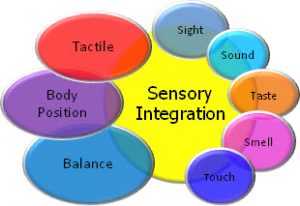Sensory Processing- What it is and What to Do About It
At Grafton we often hear about “sensory stuff”, or students who have “sensory issues”. But what does that really mean? Each one of us uses input we receive from our senses in order to make sense of and navigate the world around us. This simply means that we use our vision, hearing, smell, taste, and touch, as well as our “invisible” senses that tell us where our body is in space, in order to interact with our world by walking, talking, listening, eating, and reading this article on your computer screen. These systems sometimes fall out of sync though, either due to environmental conditions, genetics, or challenges, such as ADHD or autism. Trouble with these systems can cause difficulty with how we relate and perceive the world around us and how we interact with it.
Sensory Modulation: When sensory information enters the body and brain, sometimes it is perceived as too little or too much, resulting in under-responsiveness, over-responsiveness, or sensory seeking behaviors. This can cause various maladaptive responses, including no response at all, or very little response to something that should cause a stronger reaction (like showing no reaction to a loud noise), what appears to be an overreaction (gagging when given unwanted food), avoiding a sensory input (eloping, hiding, or shutting down), or seeking more intense sensory input (like jumping, rocking, or seeking deep pressure).

Sensory Discrimination: When we take in sensory information with our eyes, ears, nose, mouth, skin, and muscles, that information travels to the brain, where it is interpreted, and then is translated to actions. Sometimes this information isn’t interpreted correctly or accurately, and an individual will struggle with sensory discrimination. In other words, sensory discrimination is the processing that helps us to determine the, “what”, “where”, and “when” of the sensory information we take in.
Sensory-Based Movement Disorders: When certain sensory systems do not work together, it can result in trouble with movement in conditions like dyspraxia, postural disorders, or Developmental Coordination Disorder (DCD). Kids with sensory related movement problems often appear to be clumsy, have poor balance and core strength, show less coordination skills, or can have muscles that seem “too tight” or “too loose”. They sometimes show signs of “dyspraxia” and have difficulty not only with motor coordination, or “motor output”, but also with figuring out the “what” action to take (motor ideation), and “how” to carry out an action (motor planning). For instance, an individual might want to write their name, but not know “what” strokes to make to form the letter, or “how” to hold a pencil in a way that makes marks on paper.
Specific Sensory Systems: Below is a short description of difficulties people can have when each system isn’t working quite right, as well as a few activity ideas on how to help develop those sensory systems:
Visual Processing: Trouble with visual processing can often lead to visual perceptual issues, including paying less attention to relevant visual information, sloppy handwriting, and difficulty distinguishing shapes and sizes of objects.
Supporting Activities: Games and books like “I spy”, letter or word searches, handwriting and tracing, coloring, sorting matching, playing with lights, and making sensory bottles
Auditory Processing: When there is difficulty in distinguishing sounds, there is also often delayed or impaired understanding and response to things said, and trouble knowing what sounds to pay attention to.
Supporting Activities: Making and playing with musical toys, repeat back short clapping or musical patterns, moving to music, or games like “Marco Polo”, or blindfolded “obstacle courses”
Smell and taste Processing: Oversensitivity to different tastes, seeking out smells, and trouble distinguishing tastes and temperatures of food
Supporting Activities: Aromatherapy with essential oils, scratch and sniff stickers or scented markers, or trying new foods
Tactile Processing: Our tactile system, or touch, is a sense developed very early and life, and has connections in the brain to feelings of comfort and safety. Difficulties with this system can result in less awareness of textures, hypersensitivity to textures and touch (which often results in picky eaters!), or seeking tactile sensation- think playing with water when washing hands or drinking.
Supporting Activities: Making sensory bags or balloons with things like rice, beans, or sand, use play doh, shaving cream, or fidget toys, or provide sensory bins
Proprioceptive Processing: Sensed by your muscles and joints, and helps you to determine where your body is in space. Close your eyes and touch your fingertip to your nose. Were you able to do this without being to see either your finger or your nose? This is because of proprioception.
Supporting Activities: Creating “heavy work” opportunities, like carrying items during transitions or helping with chores, Exercise that involves input to the joints, like lifting, climbing, running, jumping, yoga, or pilates, and comforting input to muscles like hugs or weighted vests
Vestibular Processing: This system relies on bones and fluid in the inner ear, and detects our direction of movement, changes in gravity, vibrations, and the relationship between head positioning and the rest of the body. It is closely linked with vision and hearing. When the vestibular system isn’t working quite right, it can result in dizziness, fear of sudden movement or heights, and muscles that seem loose and floppy, or weaker but more flexible.
Supporting Activities: Swinging, climbing, sliding, yoga, movement games and songs, balancing activities, and activities that use visual pursuit (like turning the head and eyes together to watch bubbles float by).
Hopefully this provides a starting point for better understanding all of that “sensory stuff” we tend to hear about. If you have any questions about how sensory processing affects or can be addressed with an individual student, always feel free to ask their occupational therapist!